消费者行为学6
- 格式:pptx
- 大小:149.41 KB
- 文档页数:26
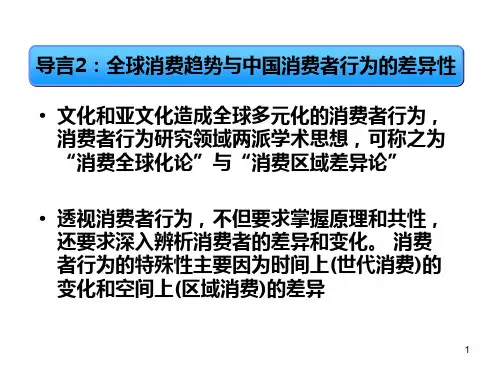
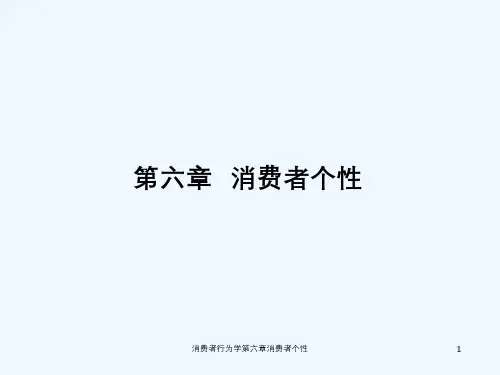
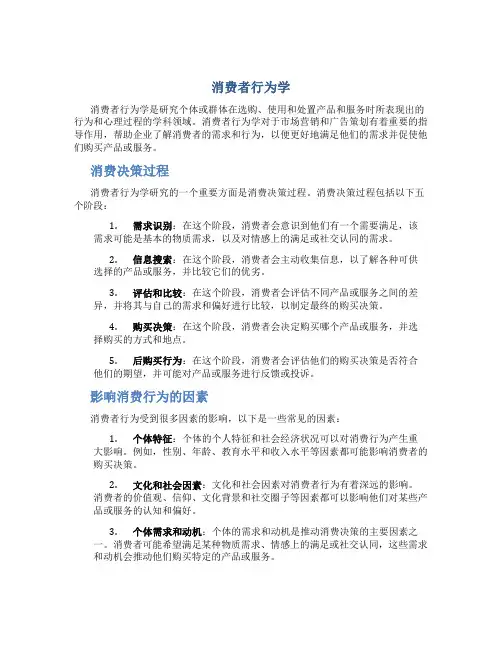
消费者行为学消费者行为学是研究个体或群体在选购、使用和处置产品和服务时所表现出的行为和心理过程的学科领域。
消费者行为学对于市场营销和广告策划有着重要的指导作用,帮助企业了解消费者的需求和行为,以便更好地满足他们的需求并促使他们购买产品或服务。
消费决策过程消费者行为学研究的一个重要方面是消费决策过程。
消费决策过程包括以下五个阶段:1.需求识别:在这个阶段,消费者会意识到他们有一个需要满足,该需求可能是基本的物质需求,以及对情感上的满足或社交认同的需求。
2.信息搜索:在这个阶段,消费者会主动收集信息,以了解各种可供选择的产品或服务,并比较它们的优劣。
3.评估和比较:在这个阶段,消费者会评估不同产品或服务之间的差异,并将其与自己的需求和偏好进行比较,以制定最终的购买决策。
4.购买决策:在这个阶段,消费者会决定购买哪个产品或服务,并选择购买的方式和地点。
5.后购买行为:在这个阶段,消费者会评估他们的购买决策是否符合他们的期望,并可能对产品或服务进行反馈或投诉。
影响消费行为的因素消费者行为受到很多因素的影响,以下是一些常见的因素:1.个体特征:个体的个人特征和社会经济状况可以对消费行为产生重大影响。
例如,性别、年龄、教育水平和收入水平等因素都可能影响消费者的购买决策。
2.文化和社会因素:文化和社会因素对消费者行为有着深远的影响。
消费者的价值观、信仰、文化背景和社交圈子等因素都可以影响他们对某些产品或服务的认知和偏好。
3.个体需求和动机:个体的需求和动机是推动消费决策的主要因素之一。
消费者可能希望满足某种物质需求、情感上的满足或社交认同,这些需求和动机会推动他们购买特定的产品或服务。
4.市场营销策略:企业的市场营销策略可以直接影响消费者的购买决策。
例如,产品的定价、推广和分销策略等都可以影响消费者对产品或服务的认知和购买意愿。
5.个体认知和态度:个体的认知和态度也会影响他们的消费行为。
消费者的认知和判断能力、对产品或服务的态度和偏好等都会在购买决策中发挥重要作用。
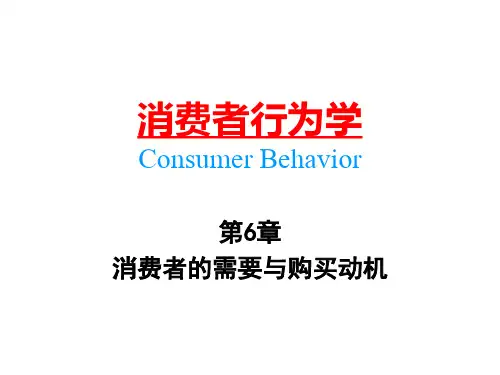
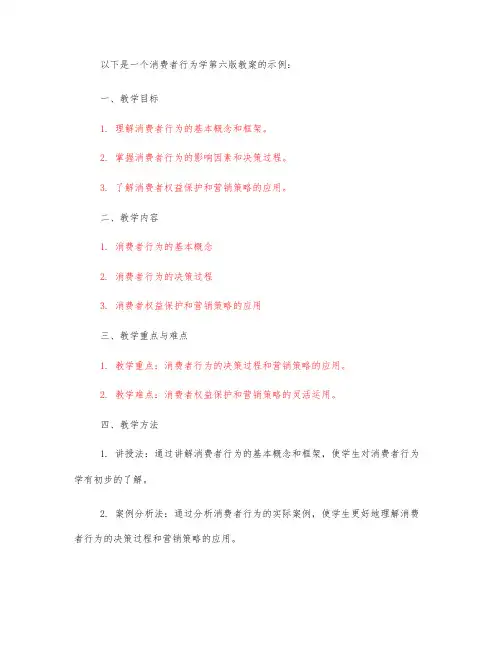
以下是一个消费者行为学第六版教案的示例:一、教学目标1. 理解消费者行为的基本概念和框架。
2. 掌握消费者行为的影响因素和决策过程。
3. 了解消费者权益保护和营销策略的应用。
二、教学内容1. 消费者行为的基本概念2. 消费者行为的决策过程3. 消费者权益保护和营销策略的应用三、教学重点与难点1. 教学重点:消费者行为的决策过程和营销策略的应用。
2. 教学难点:消费者权益保护和营销策略的灵活运用。
四、教学方法1. 讲授法:通过讲解消费者行为的基本概念和框架,使学生对消费者行为学有初步的了解。
2. 案例分析法:通过分析消费者行为的实际案例,使学生更好地理解消费者行为的决策过程和营销策略的应用。
3. 小组讨论法:通过小组讨论,使学生更好地掌握消费者权益保护和营销策略的灵活运用。
五、教学步骤1. 导入新课:通过引入消费者行为的基本概念和框架,引导学生思考消费者行为的影响因素和决策过程。
2. 讲授新课:讲解消费者行为的基本概念、决策过程和营销策略的应用,并辅以案例分析。
3. 巩固练习:通过小组讨论,使学生更好地掌握消费者权益保护和营销策略的灵活运用。
4. 归纳小结:回顾本节课的重点和难点,总结消费者行为学的基本框架和营销策略的应用。
六、作业布置1. 阅读教材相关章节,整理笔记。
2. 搜集一个消费者行为案例,进行分析并撰写报告。
3. 小组讨论:针对某一产品或品牌,制定一份营销策略,并讨论该策略的优劣和可行性。
七、评价与反馈1. 评价方式:通过小组报告、课堂讨论和作业完成情况,评价学生的学习效果。
2. 反馈方式:针对学生的学习情况,给予及时的反馈和指导,帮助学生更好地掌握消费者行为学的内容和应用。

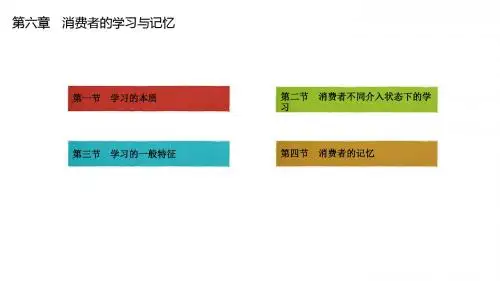
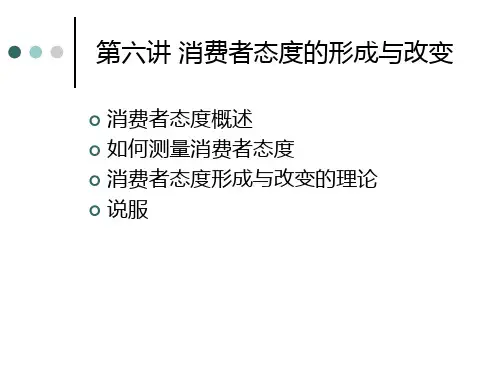
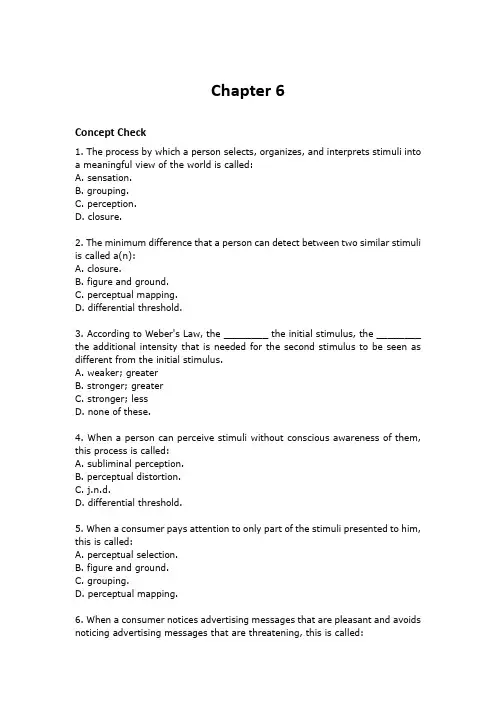
Chapter 6Concept Check1. The process by which a person selects, organizes, and interprets stimuli intoa meaningful view of the world is called:A. sensation.B. grouping.C. perception.D. closure.2. The minimum difference that a person can detect between two similar stimuli is called a(n):A. closure.B. figure and ground.C. perceptual mapping.D. differential threshold.3. According to Weber's Law, the ________ the initial stimulus, the ________ the additional intensity that is needed for the second stimulus to be seen as different from the initial stimulus.A. weaker; greaterB. stronger; greaterC. stronger; lessD. none of these.4. When a person can perceive stimuli without conscious awareness of them, this process is called:A. subliminal perception.B. perceptual distortion.C. j.n.d.D. differential threshold.5. When a consumer pays attention to only part of the stimuli presented to him, this is called:A. perceptual selection.B. figure and ground.C. grouping.D. perceptual mapping.6. When a consumer notices advertising messages that are pleasant and avoids noticing advertising messages that are threatening, this is called:B. perceptual mapping.C. selective exposure.D. product placement.7. When TiVo allows a television viewer to skip over TV commercials, this helps the perceptual process called:A. sensory adaptation.B. j.n.d.C. perceptual blocking.D. perceptual mapping.8. The total of a consumer's expectations of a service (e.g. a plane ride from St. Louis to Chicago) is known as that consumer's:A. perceived risk.B. post hoc service.C. figure and ground.D. predicted service.9. Because high-risk perceivers limit their product choices to a few "safe" alternative products, they are called:A. narrow categorizers.B. j.n.d. categorizersC. grouping categorizers.D. broad categorizers.10. When Tom Cruise drinks a Diet Coke in a movie, this is an example of a(n):A. absolute threshold.B. product placement.C. perceptual mapping.D. perceptual blocking.Concept Challenge1. Another term for the consumer's differential threshold is:A. absolute threshold.B. consumer imagery.C. perceptual blocking.D. j.n.d.2. According to Weber's Law, an additional level of stimulus must be ________ for the majority of consumers to perceive a difference between the resulting stimulus and the initial stimulus.A. subtractedB. multipliedD. divided3. Consumers subconsciously "screen out" stimuli that they find threatening and this is called:A. perceptual defense.B. closure.C. perceptual mapping.D. j.n.d.4. We tend to remember our home phone numbers in three groups called ________ (e.g. area code, first three digits, last four digits).A. placementB. mapsC. chunksD. grouping5. The "image" of a product in the mind of a consumer compared to competitive products is that product's:A. perceptual mapping.B. perceptual selection.C. positioning.D. perceptual distortion.6. McDonald's advertising slogan: "You deserve a break today at McDonald's," is an example of:A. finding an unowned position.B. positioning against the competition.C. positioning based on a specific benefit.D. umbrella positioning.7. Wendy's slogan: "Where's the beef?" is an example of:A. filling several positions.B. positioning based on a specific benefit.C. umbrella positioning.D. positioning against the competition.8. FedEx's slogan: "When it absolutely, positively has to be there overnight," is an example of:A. positioning based on a specific benefit.B. finding an unowned position.C. positioning against the competition.D. umbrella positioning.9. When consumers perceive a lesser degree of risk in purchasing a stereo thana laptop computer, this is called a(n):A. sensory adaptation.B. product-category perceived risk.C. subliminal perception.D. perceptual blocking.10. When Tom Hanks eats a Milky Way candy bar during an important scent ina movie, this is an example of:A. perceptual blocking.B. product placement.C. sensory adaptation.D. perceptual mapping.。
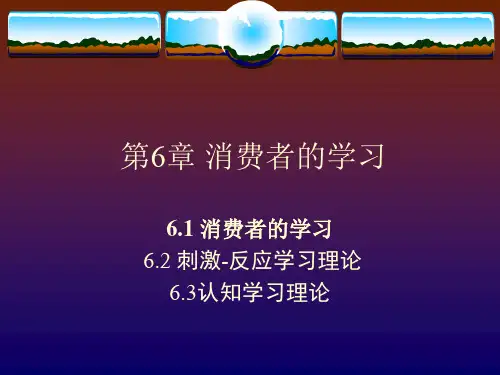
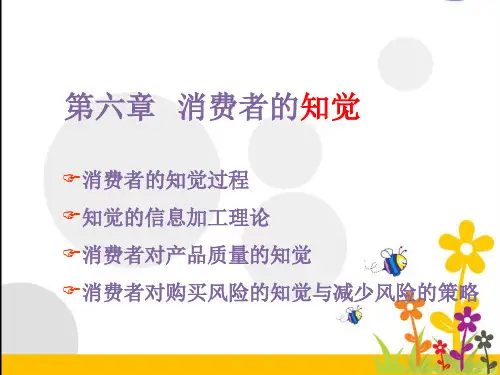
第一单元1消费者行为学的定义是什么?答:他是研究个体或群体为满足需要与欲望而挑选,购买,使用或处置产品,服务,观念或经验所涉及的过程。
2市场细分的定义是什么?答:它是指以消费者需求的某些特征或变量为依据,区分具有不同需要的顾客群体。
3、什么是角色理论?答:(从角色的观点出发,来分析,研究一个人的社会行为活动。
)许多消费者行为类似于戏剧情节的过程。
1,C2C与B2C电子商务之间有什么区别?答:C2C是顾客对顾客之间的交易。
如网上拍卖等,比较大众化。
B2C是商业机构对消费者,以网络零售业为主。
2,什么是消费成瘾?请举出两个例子!答:消费成瘾是一种生理和心理上对产品或服务的依赖。
如饮酒,毒瘾,吸烟,网游隐,互联网成瘾等。
第二单元1,举例说明享乐性消费者的定义答:哈雷—戴维森公司试图注册由摩托车发动机加速转动而产生的独特声音。
这种反应是享乐性消费的一个重要部分,也是消费者与产品相互作用的多重感觉,幻想与感情方面。
现在的消费者越来越喜欢购买那些能够带来享乐价值的东西,而不是只看重产品的基本功能。
(指越来越喜欢购买那些能够带来享乐价值的东西,而不是看中产品的基本功能消费者。
)2,辨别并描述知觉的三个阶段。
答:三阶段是:暴露、注意、解释。
暴露:是一个刺激进入个人感觉器官的范围内。
注意:指信息加工行为对特定刺激的投入程度。
解释:指我们赋予感觉刺激物的意义。
3,绝对阈限和差别阈限的定义。
答:绝对阈限是指特定感觉渠道所能察觉到的最小刺激量。
差别阈限指感觉系统觉察两种刺激之间的差别或者变化的能力。
4,导致刺激适应的因素有哪些?答:适应是指消费者对某个刺激持续注意的程度。
影响的因素主要有强度,持续时间,甄别,暴露和关联性。
5,超真实的概念是什么?答:超真实指将初始虚拟的或者假设变为真实的过程。
(嫦娥奔月—人造卫星、航空母舰act。
)6,什么是定位战略?营销者可以用来为产品定位的方式有哪些?答|:定位战略是一家公司营销努力的最基本元素,它通过营销组合元素(如产品设计、价格、分销和营销沟通等)来影响消费者对市场意义的理解。
国家开放大学电大《消费者行为学》终结性网考机考2套题库及答案六【答案】绿色贸易壁垒2.按照消费者问题解决的方式,价值低、次数频的商品的购买决策属于()。
【答案】常规反应决策3.关于顺从的正确表述是()。
【答案】情绪好的时候人们顺从的可能性更大4.在人对现实的态度和相应的行为方式中的比较稳定的、具有核心意义的个性心理特征被称为()。
【答案】性格5.关于消费者感知与产品实际质量的关系,下列表述正确的是()。
【答案】实际的质量上升,消费者感知上升,消费者购买时还会有重复性购买行为6.网络营销具有极强的互动性,可促进消费者的主动性沟通,真正实现了企业与消费者的()。
【答案】“一对一”营销7.按照我国有关法律规定,当发生损害消费者权益的问题时,首先本着()的原则来处理问题。
【答案】谁经销谁负责8.空巢期Ⅱ阶段的消费者表现为()。
【答案】消费日趋理性,决策慎重,已经形成比较稳定的购买习惯9.由人所处社会环境因素决定的,以生理因素为基础的社会状态下的需要,属于()。
【答案】社会性消费行为10.()是指人们从宣传绿色消费、提倡绿色消费到对绿色消费的自觉服从和主动追求的过程,是外在压力转化为内在动力的自我约束。
【答案】绿色消费意识11.根据动机理论中的双因素理论,商品的必备条件是()。
【答案】保健因素12.顺利完成某一活动所必需的主观条件,可直接影响活动效率,并使活动顺利完成的个性心理特征被称为()。
【答案】能力13.根据霍夫斯塔德提出的四个维度,人们对在组织或机构内对权力较少的成员的权力分配不平等这一事实的接受程度被称为()。
【答案】权力距离14.个体在内外条件刺激下,对某些事物希望得到满足时的一种心理紧张状态被称为()。
【答案】需要15.只有相等单位而没有绝对零点,根据()不仅可以知道两事物之间在某种特点上有无差别,还可以知道它们相差多少。
【答案】等差量表二、多选题(共10题,共10分)1.在消费者行为学中,下列哪几项属于商品或服务的范畴()。